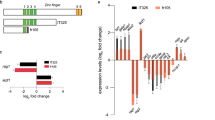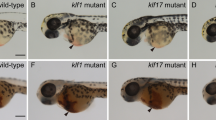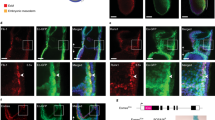Abstract
TATA-box-binding protein (TBP)-related factor 3, TRF3 (also called TBP2), is a vertebrate-specific member of the TBP family that has a conserved carboxy-terminal region and DNA-binding domain virtually identical to that of TBP (ref. 1). TRF3 is highly expressed during embryonic development, and studies in zebrafish and Xenopus have shown that it is required for normal embryogenesis2,3. Here we show that zebrafish embryos depleted of Trf3 exhibit multiple developmental defects and, in particular, fail to undergo haematopoiesis. Expression profiling for Trf3-dependent genes identified mespa, which encodes a transcription factor whose murine orthologue is required for mesoderm specification4, and chromatin immunoprecipitation verified that Trf3 binds to the mespa promoter. Depletion of Mespa resulted in developmental and haematopoietic defects markedly similar to those induced by Trf3 depletion. Injection of mespa messenger RNA (mRNA) restored normal development to a Trf3-depleted embryo, indicating mespa is the single Trf3 target gene required for zebrafish embryogenesis. Zebrafish embryos depleted of Trf3 or Mespa also failed to express cdx4, a caudal-related gene required for haematopoiesis. Mespa binds to the cdx4 promoter, and epistasis analysis revealed an ordered trf3–mespa–cdx4 pathway. Thus, in zebrafish, commitment of mesoderm to the haematopoietic lineage occurs through a transcription factor pathway initiated by a TBP-related factor.
This is a preview of subscription content, access via your institution
Access options
Subscribe to this journal
Receive 51 print issues and online access
$199.00 per year
only $3.90 per issue
Buy this article
- Purchase on Springer Link
- Instant access to full article PDF
Prices may be subject to local taxes which are calculated during checkout



Similar content being viewed by others
Accession codes
Primary accessions
ArrayExpress
Data deposits
The microarray data have been deposited in the ArrayExpress database at http://www.ebi.ac.uk/arrayexpress under the accession number E-MEXP-1279.
References
Persengiev, S. P. et al. TRF3, a TATA-box-binding protein-related factor, is vertebrate-specific and widely expressed. Proc. Natl Acad. Sci. USA 100, 14887–14891 (2003)
Bartfai, R. et al. TBP2, a vertebrate-specific member of the TBP family, is required in embryonic development of zebrafish. Curr. Biol. 14, 593–598 (2004)
Jallow, Z., Jacobi, U. G., Weeks, D. L., Dawid, I. B. & Veenstra, G. J. Specialized and redundant roles of TBP and a vertebrate-specific TBP paralog in embryonic gene regulation in Xenopus . Proc. Natl Acad. Sci. USA 101, 13525–13530 (2004)
Kitajima, S., Takagi, A., Inoue, T. & Saga, Y. MesP1 and MesP2 are essential for the development of cardiac mesoderm. Development 127, 3215–3226 (2000)
Muller, F., Lakatos, L., Dantonel, J., Strahle, U. & Tora, L. TBP is not universally required for zygotic RNA polymerase II transcription in zebrafish. Curr. Biol. 11, 282–287 (2001)
Davidson, A. J. et al. cdx4 mutants fail to specify blood progenitors and can be rescued by multiple hox genes. Nature 425, 300–306 (2003)
Sumanas, S. & Lin, S. Ets1-related protein is a key regulator of vasculogenesis in zebrafish. PLoS Biol. 4, e10 (2006)
Davidson, A. J. & Zon, L. I. The caudal-related homeobox genes cdx1a and cdx4 act redundantly to regulate hox gene expression and the formation of putative hematopoietic stem cells during zebrafish embryogenesis. Dev. Biol. 292, 506–518 (2006)
Langeland, J. & Kimmel, C. B. in Embryology: Constructing the Organism (eds Gilbert, S. F. & Raunio, A. M.) 383–407 (Sinauer Associates, Sunderland, Massachusetts, 1997)
Vogeli, K. M., Jin, S. W., Martin, G. R. & Stainier, D. Y. A common progenitor for haematopoietic and endothelial lineages in the zebrafish gastrula. Nature 443, 337–339 (2006)
Westerfield, M. The Zebrafish Book. A Guide for the Laboratory Use of Zebrafish (Danio rerio) (Univ. of Oregon Press, Eugene, 1993)
Kimmel, C. B., Ballard, W. W., Kimmel, S. R., Ullmann, B. & Schilling, T. F. Stages of embryonic development of the zebrafish. Dev. Dyn. 203, 253–310 (1995)
Turner, D. L. & Weintraub, H. Expression of achaete-scute homolog 3 in Xenopus embryos converts ectodermal cells to a neural fate. Genes Dev. 8, 1434–1447 (1994)
Beverley, S. M. Enzymatic amplification of RNA by PCR (RT-PCR). In Current Protocols in Molecular Biology (eds Ausubel, F. M. et al.) Ch. 15.5.1–15.5.6 (John Wiley & Sons, Hoboken, New Jersey, 2001)
Hauptmann, G. & Gerster, T. Two-color whole-mount in situ hybridization to vertebrate and Drosophila embryos. Trends Genet. 10, 266 (1994)
Thisse, B. et al. Expression of the zebrafish genome during embryogenesis (NIH R01 RR15402). ZFIN Direct Data Submission [online] 〈http://zebrafish.org/zirc.home/guide.php〉 (2001)
Lawson, N. D. & Weinstein, B. M. In vivo imaging of embryonic vascular development using transgenic zebrafish. Dev. Biol. 248, 307–318 (2002)
Acknowledgements
We thank C. Sagerstrom and M. Tsang for reagents, the Kimmel Cancer Center Microarray Core Facility at Thomas Jefferson University for performing the microarray analysis, members of the Lawson laboratory for technical support, and S. Evans for editorial assistance. The Zebrafish International Resource Center is supported by a grant from the National Institutes of Health – National Center for Research Resources (NIH-NCRR). This work was supported in part by a grant from the National Institutes of Health to M.R.G. M.R.G. is an investigator of the Howard Hughes Medical Institute.
Author Contributions D.O.H., N.D.L. and M.R.G. conceived and designed the experiments. D.O.H. performed the experiments, with the assistance of N.D.L., who performed the experiments shown in Supplementary Fig. 2, and T.R., who performed the chromatin immunoprecipitation assays shown in Fig. 1b and Supplementary Fig. 10a. D.O.H., T.R., N.D.L. and M.R.G. analysed the data. D.O.H., N.D.L. and M.R.G. wrote the paper.
Author information
Authors and Affiliations
Corresponding authors
Supplementary information
Supplementary Figures 1-10 and Supplementary Tables 1 and 2
This file contains 10 figures showing various control experiments that monitor trf3 and tbp expression during development, show Trf3- and Mespa-depleted embryos, confirm rescue of Trf3-depleted embryos following injection of mespa mRNA, and show Trf3 and Mespa are required for expression of several Cdx4-dependent hox genes. The file also contains 2 tables listing the genes that are significantly down-regulated upon Trf3 depletion and the sequences of all primers used in this paper. (PDF 1004 kb)
Supplementary Data
This file contains Microarray Data. The complete list of genes induced or repressed by trf3 MO treatment. (XLS 2330 kb)
Supplementary Corrigendum
The file contains Corrigendum for Supplementary Information. This file was uploaded on 13 December 2007 (PDF 21 kb)
Rights and permissions
About this article
Cite this article
Hart, D., Raha, T., Lawson, N. et al. Initiation of zebrafish haematopoiesis by the TATA-box-binding protein-related factor Trf3. Nature 450, 1082–1085 (2007). https://doi.org/10.1038/nature06349
Received:
Accepted:
Published:
Issue Date:
DOI: https://doi.org/10.1038/nature06349
This article is cited by
-
TATA box-binding protein-related factor 3 drives the mesendoderm specification of human embryonic stem cells by globally interacting with the TATA box of key mesendodermal genes
Stem Cell Research & Therapy (2020)
-
TRF2 is recruited to the pre-initiation complex as a testis-specific subunit of TFIIA/ALF to promote haploid cell gene expression
Scientific Reports (2016)
-
TBP-related factors: a paradigm of diversity in transcription initiation
Cell & Bioscience (2011)
-
Unexpected roles for core promoter recognition factors in cell-type-specific transcription and gene regulation
Nature Reviews Genetics (2010)
-
TBP2 is a substitute for TBP in Xenopus oocyte transcription
BMC Biology (2009)
Comments
By submitting a comment you agree to abide by our Terms and Community Guidelines. If you find something abusive or that does not comply with our terms or guidelines please flag it as inappropriate.



